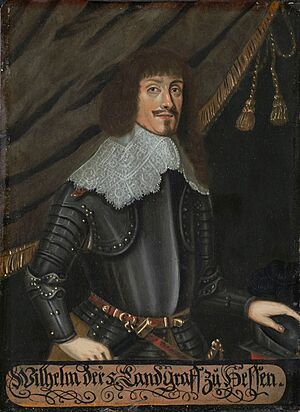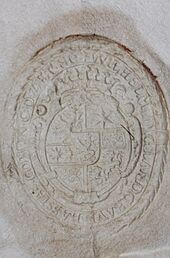William V, Landgrave of Hesse-Kassel facts for kids
Quick facts for kids William V |
|
|---|---|
 |
|
| Landgrave of Hesse-Kassel | |
| Reign | 17 March 1627 – 21 September 1637 |
| Predecessor | Maurice |
| Successor | William VI |
| Born | 13 February 1602 Kassel, Hesse-Kassel |
| Died | 21 September 1637 (aged 35) Leer, East Frisia |
| Burial | Martinskirche, Kassel |
| Spouse |
Amalie Elisabeth von Hanau-Münzenberg
(m. 1619) |
| Issue |
|
| House | Hesse-Kassel |
| Father | Maurice, Landgrave of Hesse-Kassel |
| Mother | Agnes of Solms-Laubach |
| Religion | Calvinism |
William V (German: Wilhelm) was a powerful ruler, known as a Landgrave (a type of German prince). He was born on February 13, 1602, and ruled the region of Hesse-Kassel from 1627 until his death on September 21, 1637. William became ruler during a very tough time, right in the middle of a huge conflict called the Thirty Years' War. This made his rule very challenging, and his lands and money suffered a lot.
Contents
William V's Early Life and Challenges
William was born in Kassel, a city in Hesse-Kassel. His father was Landgrave Maurice, and his mother was Agnes of Solms-Laubach. Sadly, William's mother passed away soon after he was born. His father later married Countess Juliane of Nassau-Siegen.
William's father, Maurice, was a very educated man with many interests. He inherited some lands in 1604. However, when he changed his religion to Calvinism a year later, he got into a long legal fight. This fight was with his cousin, Louis V, who followed Lutheranism.
The Aulic Council, a high court, decided in favor of Louis. On March 17, 1627, after losing much land and money, Maurice gave up his rule. He handed over control to his son, William.
Fixing the Land and Money Problems
William's first job as Landgrave was to follow the court's decision. He also had to fix the money problems in Hesse-Kassel. He worked to stop the "Kipper und Wipper" crisis, which was a time when coins lost their value. He also tried to reduce the huge amount of debt his family had.
William V and the Thirty Years' War
The Thirty Years' War was a major conflict happening in Europe. William decided to make an alliance with his relative, King Gustavus Adolphus of Sweden. The Swedish army arrived in Pomerania on July 6, 1630.
As a military leader, William successfully pushed out the Imperial troops from Hesse. After a big Protestant victory at the Battle of Breitenfeld in 1631, King Gustavus Adolphus gave William control over several important religious areas. These included the abbeys of Fulda, Hersfeld, and Corvey. He also gained control of the prince-bishoprics of Paderborn and Münster.
William took control of Hersfeld and the Mainz estate of Fritzlar. However, when he and Gustavus Adolphus entered the city of Frankfurt, his cousin George II, who was allied with Emperor Ferdinand II, became worried. George II started talking with the Swedish king.
William's hopes were not fully met. Gustavus Adolphus only took the Rüsselsheim fortress and left Upper Hesse to Landgrave George. William's situation got worse when the king was killed in the Battle of Lützen in 1632.
Later Years and Exile
In 1635, the Emperor made a peace agreement called the Peace of Prague with many Protestant princes. William was left out of this agreement. Instead, he formed a military alliance with France. This decision led to Imperial troops invading his lands.
William lost Fulda and his lands in Westphalia again. He also fell into even more debt. He was declared an "enemy of the Empire." His cousin George was put in charge of the Hesse-Kassel lands instead.
In 1636, William's forces and the Swedish commander Alexander Leslie managed to free the besieged fortress of Hanau. But by 1637, all of Hesse-Kassel was under military control. William was forced to flee his home. He died in exile in East Frisia.
William's Legacy
William's wife, Amalie Elisabeth von Hanau-Münzenberg, became the ruler for their young son, William VI, Landgrave of Hesse-Kassel. She ruled until her son was old enough in 1650. Under her strong leadership, many of the lands lost by her husband and his father were won back. She did this through smart alliances with other countries and battles.
In 1650, William's son, William VI, began his own rule as Landgrave. He continued the Hesse-Kassel family line, which had almost ended under Maurice and William V.
One of William V's daughters, Charlotte, married Charles I Louis, Elector Palatine. She was the mother of the famous Duchess of Orléans, who was the sister-in-law of King Louis XIV. Another daughter, Emily, married Henri Charles de La Trémoille.
William V's Children
William V and his wife, Amalie Elisabeth, had many children:
- Agnes (1620 – 1626)
- Maurice (born and died 1621)
- Elisabeth (1623 – 1624)
- William (1625 – 1626)
- Emilie (1626 – 1693), who married Henri Charles de La Trémoille.
- Charlotte (1627 – 1686), who married Charles I Louis of the Palatinate.
- William VI, Landgrave of Hesse-Kassel (1629 – 1663), who married Margravine Hedwig Sophie of Brandenburg.
- Philipp (1630 – 1638)
- Adolf (1631 – 1632)
- Karl (1633 – 1635)
- Elisabeth (1634 – 1688), who became a Princess-Abbess at Herford.
- Luise (1636 – 1638)


